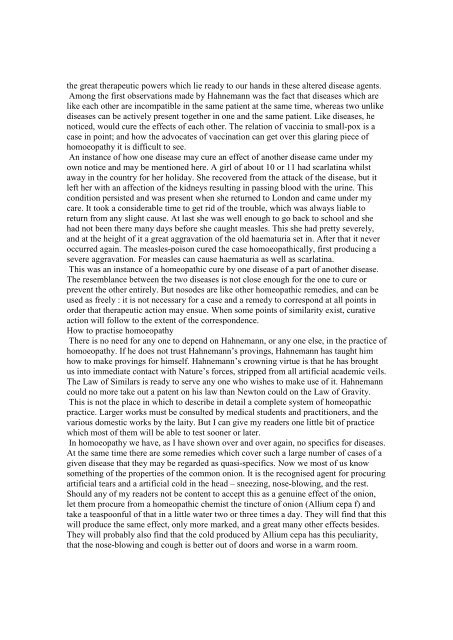CLARKE JH, Homoeopathy Explained - Classical Homeopathy Online
CLARKE JH, Homoeopathy Explained - Classical Homeopathy Online
CLARKE JH, Homoeopathy Explained - Classical Homeopathy Online
Create successful ePaper yourself
Turn your PDF publications into a flip-book with our unique Google optimized e-Paper software.
the great therapeutic powers which lie ready to our hands in these altered disease agents.<br />
Among the first observations made by Hahnemann was the fact that diseases which are<br />
like each other are incompatible in the same patient at the same time, whereas two unlike<br />
diseases can be actively present together in one and the same patient. Like diseases, he<br />
noticed, would cure the effects of each other. The relation of vaccinia to small-pox is a<br />
case in point; and how the advocates of vaccination can get over this glaring piece of<br />
homoeopathy it is difficult to see.<br />
An instance of how one disease may cure an effect of another disease came under my<br />
own notice and may be mentioned here. A girl of about 10 or 11 had scarlatina whilst<br />
away in the country for her holiday. She recovered from the attack of the disease, but it<br />
left her with an affection of the kidneys resulting in passing blood with the urine. This<br />
condition persisted and was present when she returned to London and came under my<br />
care. It took a considerable time to get rid of the trouble, which was always liable to<br />
return from any slight cause. At last she was well enough to go back to school and she<br />
had not been there many days before she caught measles. This she had pretty severely,<br />
and at the height of it a great aggravation of the old haematuria set in. After that it never<br />
occurred again. The measles-poison cured the case homoeopathically, first producing a<br />
severe aggravation. For measles can cause haematuria as well as scarlatina.<br />
This was an instance of a homeopathic cure by one disease of a part of another disease.<br />
The resemblance between the two diseases is not close enough for the one to cure or<br />
prevent the other entirely. But nosodes are like other homeopathic remedies, and can be<br />
used as freely : it is not necessary for a case and a remedy to correspond at all points in<br />
order that therapeutic action may ensue. When some points of similarity exist, curative<br />
action will follow to the extent of the correspondence.<br />
How to practise homoeopathy<br />
There is no need for any one to depend on Hahnemann, or any one else, in the practice of<br />
homoeopathy. If he does not trust Hahnemann’s provings, Hahnemann has taught him<br />
how to make provings for himself. Hahnemann’s crowning virtue is that he has brought<br />
us into immediate contact with Nature’s forces, stripped from all artificial academic veils.<br />
The Law of Similars is ready to serve any one who wishes to make use of it. Hahnemann<br />
could no more take out a patent on his law than Newton could on the Law of Gravity.<br />
This is not the place in which to describe in detail a complete system of homeopathic<br />
practice. Larger works must be consulted by medical students and practitioners, and the<br />
various domestic works by the laity. But I can give my readers one little bit of practice<br />
which most of them will be able to test sooner or later.<br />
In homoeopathy we have, as I have shown over and over again, no specifics for diseases.<br />
At the same time there are some remedies which cover such a large number of cases of a<br />
given disease that they may be regarded as quasi-specifics. Now we most of us know<br />
something of the properties of the common onion. It is the recognised agent for procuring<br />
artificial tears and a artificial cold in the head – sneezing, nose-blowing, and the rest.<br />
Should any of my readers not be content to accept this as a genuine effect of the onion,<br />
let them procure from a homeopathic chemist the tincture of onion (Allium cepa f) and<br />
take a teaspoonful of that in a little water two or three times a day. They will find that this<br />
will produce the same effect, only more marked, and a great many other effects besides.<br />
They will probably also find that the cold produced by Allium cepa has this peculiarity,<br />
that the nose-blowing and cough is better out of doors and worse in a warm room.
















